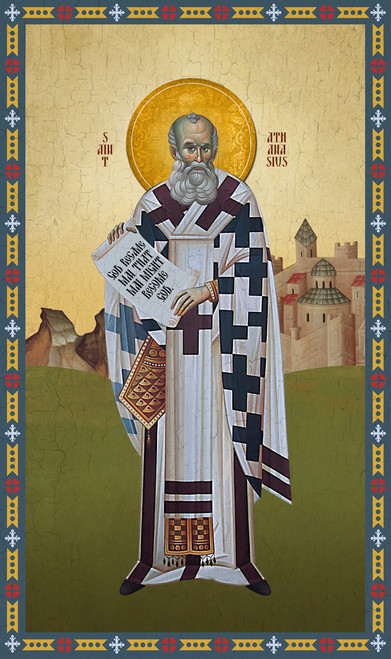St. Didier of Cahors (+580)
Commemorated November 15
St. Saint Didier, also known as Desiderius was born in the oppidum of Albi about the year 580, to a father named Salvius and a mother with the Frankish name Herchenfreda. Desiderius had two brothers, named Rusticus and Syagrius. The three boys were sent to the court of the Frankish king Clotaire II, and with other boys of noble family received an excellent education at the Merovingian court-school. St. Didier's brother Rusticus assumed holy orders at an early age and became archdeacon in the town of Rodez before being appointed abbot of the palatine basilica of Clotaire, who at length appointed him bishop of Cahors, in Quercy.
Desiderius combined a love of letters with a native Gallican eloquence, according to his Vita. While still adolescent he received the dignities of the royal household and turned his studies towards Roman (i.e. canon) law, with the result that a Roman gravity of demeanor tempered the gallic richness and brilliance of his discourse. Before long he was appointed treasurer to the king, an office that he retained under the new king, Dagobert I, whose confidant he was. After the death of Syagrius, he is said to have obtained also the prefectship of Marseilles, but this is not certain.
Faithful to the admonitions of his pious mother, three of whose letters to him are mentioned in his Vita, St. Didier led at court the serious holy life of a monk, and administered his office with great fidelity. While at court he made the acquaintance of St. Arnoux, St Ouen, and St Eloi.
In 630 his brother Rusticus, the Bishop of Cahors, was killed during a riot, whereupon the clergy and people of that city requested from the king St. Didier as his successor. By a letter of April 8, 630, Dagobert made known his consent, and Didier was consecrated Bishop of Cahors. With the other bishops of his time, many of them educated with him at the royal court, he maintained an active correspondence.
St. Didier was a zealous promoter of monastic life and founded a monastery in the vicinity of Cahors, the church of which was dedicated to St. Amantius; later on the convent was called after its founder St Géry (i.e. Dierius, from Desiderius). He directed also a convent of women, as we see from a letter written by him to the Abbess Aspasia. Under him and with his support was likewise founded in his diocese the monastery of St. Peter of Moissac. St. Didier built three large basilicas in and near Cahors (St Maria, St Peter and St Julian) and an oratory in honor of St Martin. The finished style of his building was notable, not of vernacular materials of wood, wattle and thatch, but in the manner of the ancients out of squared and hewn stones. He also built an aqueduct to serve Cahors, and rebuilt the walls and towers that protected the city, as well as the Castrum Mercurio in Cahors itself. His actions show how much the bishop acted for the public good with the authority of a count or of a patricius. St. Didier persuaded the nobles of his diocese to endow churches and monasteries.
By his testament he endowed the cathedral, the churches, and the monasteries of his episcopal city with all his estates. While resident on his estates in the district of Albi he fell ill and died at his villa of Wistrilingo, which he had presented to the monastery of St Amantius. His body was carried to Cahors and interred in the church of St Amantius.







